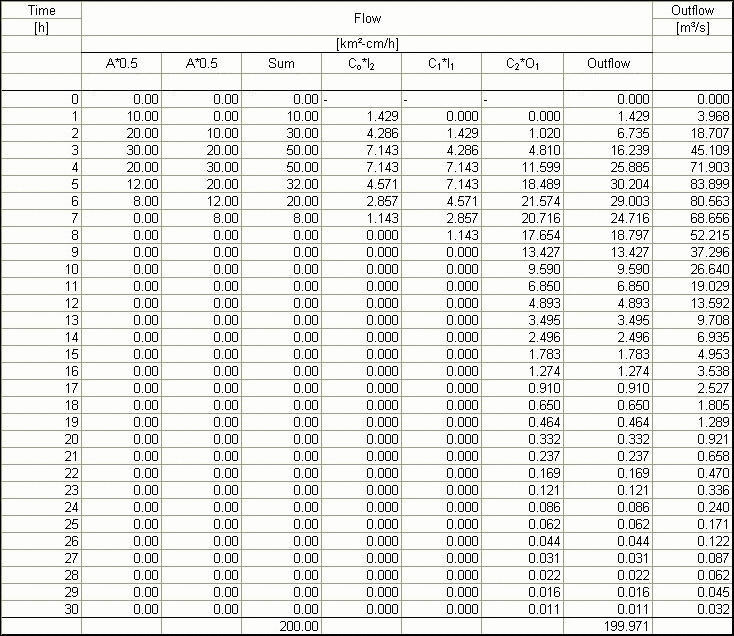SPRING 2003
SOLUTIONS TO HOMEWORK 12 , CHAPTER 10
Problem 12-1
The total rainfall depth is: P = 16 cm. With CN = 81, and R = 2.54 cm/in., the effective rainfall depth (i.e., runoff) (Eq. 5-9) is: Q = 10.56 cm. Assuming φ between 0 and 1 cm/h: [(1 - φ) • 1 + (2 - φ) • 1 + (5 - φ) • 1 + (4 - φ) • 1 + (3 - φ) • 1 + (1 - φ) • 1] = 10.56.
From which: φ = 0.91 cm/h. The total and effective rainfall pattern is:

|
The accumulated effective rainfall depth is: 10.56 cm.
The total runoff volume is: 85 km2 • 10.56 cm = 897.6 km2-cm = 8.976 hm3.
The calculations are shown in the following table:

|
The sum of outflow hydrograph ordinates is 897.6 km2-cm/h.
The integration of the outflow hydrograph results in:
897.6 km2-cm/h • 1 h = 897.6 km2-cm = 8.976 hm3, which is the same as the total runoff volume. ANSWER.
Problem 12-2
Since Δt = 1 h, and K = 3 h: Δt /K = 1/3, and from Eq. 8-16 to 8-18, the linear reservoir-routing coefficients are the following:
C0 = 1/7; C1 = 1/7; C2 = 5/7. The unit runoff volume is:
(20+40+60+40+24+16) km2 • 1 cm = 200 km2-cm = 2 hm3.
Since the duration of the SI unit hydrograph (1 cm of runoff) is 2 h, the rainfall intensity is 0.50 cm/h.

|
Problem 12-3
THANK YOU FOR RUNNING EH1000A.
THIS PROGRAM SOLVES THE CATCHMENT ROUTING PROBLEM
BY THE METHOD OF CASCADE OF LINEAR RESERVOIRS.
ENTER CATCHMENT AREA (KM2): 1000
ENTER TIME INTERVAL (H): 6
ENTER NUMBER OF RAINFALL INCREMENTS: 4
ENTER 4 NET RAINFALL INCREMENT(S) (CM), IN FREE FORMAT:
1.2 6.0 4.8 2.4
ENTER RESERVOIR STORAGE CONSTANT K (H): 12
ENTER NUMBER OF RESERVOIRS: 4
DO YOU WANT YOUR OUTPUT TO THE SCREEN (Y/N)?: y

|
THANK YOU FOR RUNNING EH1000A. PLEASE CALL AGAIN. ANSWER.
THANK YOU FOR RUNNING EH1000A.
THIS PROGRAM SOLVES THE CATCHMENT ROUTING PROBLEM
BY THE METHOD OF CASCADE OF LINEAR RESERVOIRS.
ENTER CATCHMENT AREA (KM2): 1000
ENTER TIME INTERVAL (H): 6
ENTER NUMBER OF RAINFALL INCREMENTS: 4
ENTER 4 NET RAINFALL INCREMENT(S) (CM), IN FREE FORMAT:
1.2 6.0 4.8 2.4
ENTER RESERVOIR STORAGE CONSTANT K (H): 18
ENTER NUMBER OF RESERVOIRS: 5
DO YOU WANT YOUR OUTPUT TO THE SCREEN (Y/N)?: y

|
THANK YOU FOR RUNNING EH1000A. PLEASE CALL AGAIN. ANSWER.
Problem 12-4
Using program EH 1000A, the peak outlow is 134.642 m3/s and the time-to-peak is 36 h.
The computer run for this problem is provided in the following:
THANK YOU FOR RUNNING EH1000A.
THIS PROGRAM SOLVES THE CATCHMENT ROUTING PROBLEM
BY THE METHOD OF CASCADE OF LINEAR RESERVOIRS.
ENTER CATCHMENT AREA (KM2): 485
ENTER TIME INTERVAL (H): 6
ENTER NUMBER OF RAINFALL INCREMENTS: 4
ENTER 4 NET RAINFALL INCREMENT(S) (CM), IN FREE FORMAT:
0.75 1.0 2.0 1.0
ENTER RESERVOIR STORAGE CONSTANT K (H): 10
ENTER NUMBER OF RESERVOIRS: 4
DO YOU WANT YOUR OUTPUT TO THE SCREEN (Y/N)?: y

|
THANK YOU FOR RUNNING EH1000A. PLEASE CALL AGAIN. ANSWER.